I believe that texture and contrast are two of the most important aspects of visual art because of their ability to completely change the feeling and reception of a work of art.
The five elements of design (color, shape, texture, space, and form) are the building blocks of everything you see. When these characteristics aren’t ordained by nature, but instead imposed by man, the elements can be clearly defined and controlled using design principles to create a multitude of meanings and emotions.
If the elements of design are the building blocks, then the principles of design are the tools and methods that can work those building blocks into something of value. The principles of design – unity, proportion, hierarchy, emphasis, similarity, and contrast – allow a designer to implement strategies to convey meaning and feeling through the elements.
Using texture and contrast together can establish some of the most interesting creations when the shape, space, and form are highly constrained – as in a wristwatch.
Most wristwatch design follows rather similar, predictable paths, sharing very similar construction, so the use of color and texture while applying contrast is a designer’s bread and butter.
And, yet, with the creation of extreme horology, mechanical marvels often set themselves apart simply by the innovative use of shape, space, and form.
But that needn’t be the only trick in the bag for boundary pushing. The implementation of interesting textures applied to surfaces, the use of contrast between surfaces, and playing with light and depth throughout a watch or movement provides endless avenues for creativity.
And as material science progresses, the watch industry finds itself flush with ever more ways to disrupt the conventional norms, many of which have persisted in traditional watchmaking for centuries.
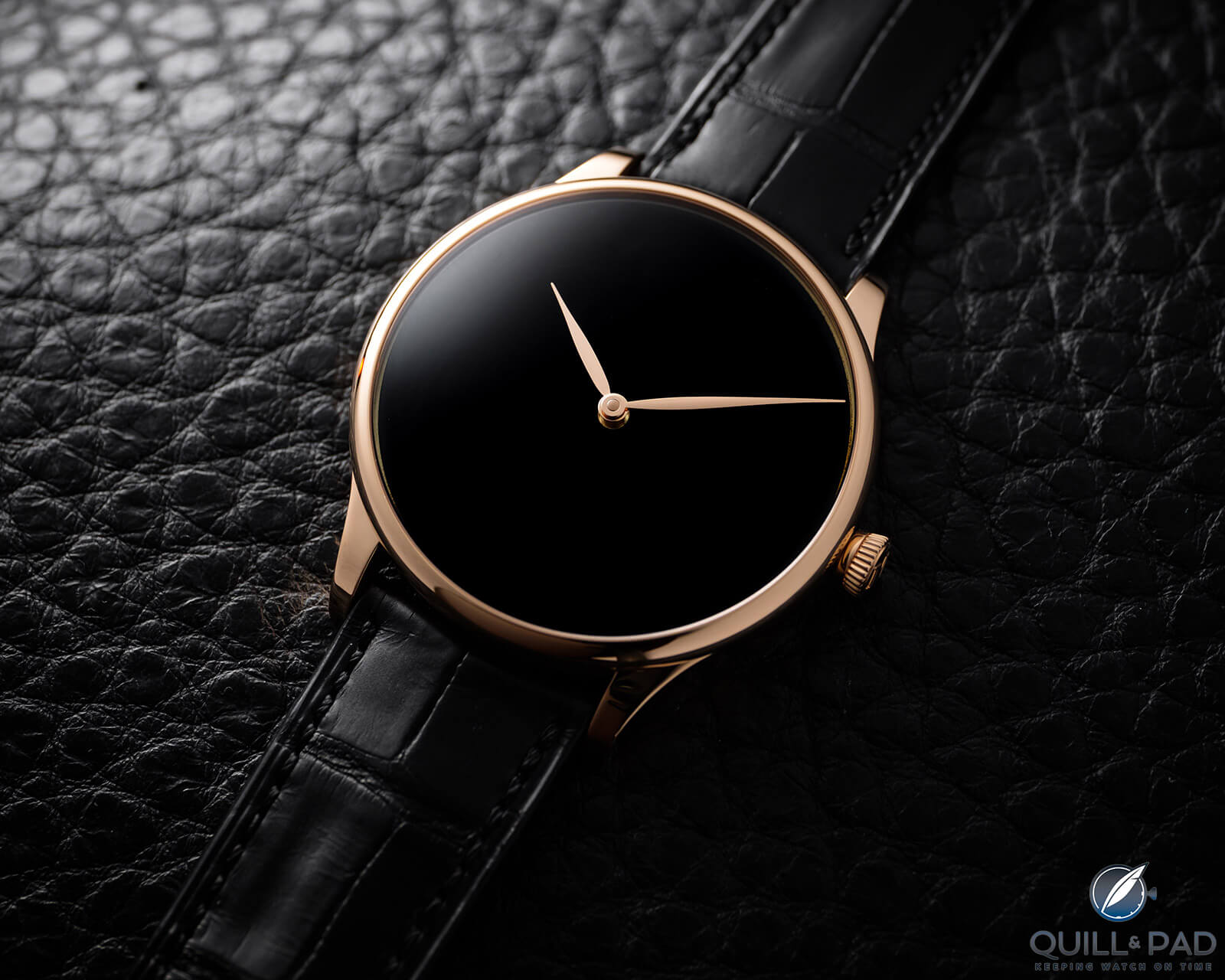
H. Moser & Cie. Venturer Concept Vantablack
Finishes lead to coatings
Historically, finishes applied to materials were of two kinds: a physical modification of the surface (brushing, striping, bead blasting, polishing, engraving, etc.) or an applied coating (paint, electroplating, galvanization, enamel, etc.), which allowed numerous choices for the look of components.
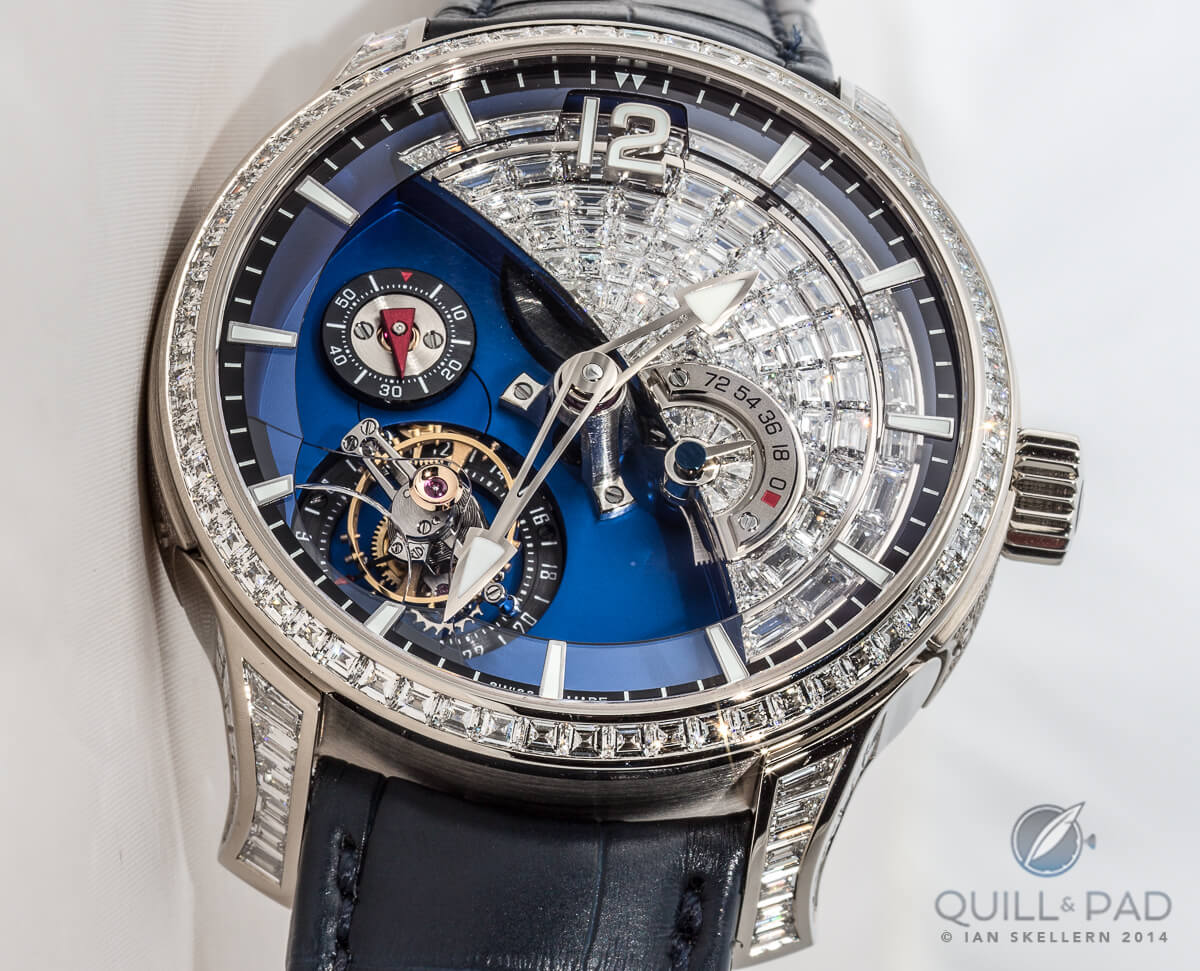
There are six plates and bridges on this Greubel Forsey Tourbillon 24 Seconds Contemporary Serti in oxidized titanium; oxidation ensures that the superlative hand-finishing is not destroyed
Typically, these were applied to flat surfaces like wheels, bridges, plates, and dials. Since coatings were usually thick and, depending on coating material, not extremely durable over time, they ended up being relegated to non-moving components and things that could be easily refinished.
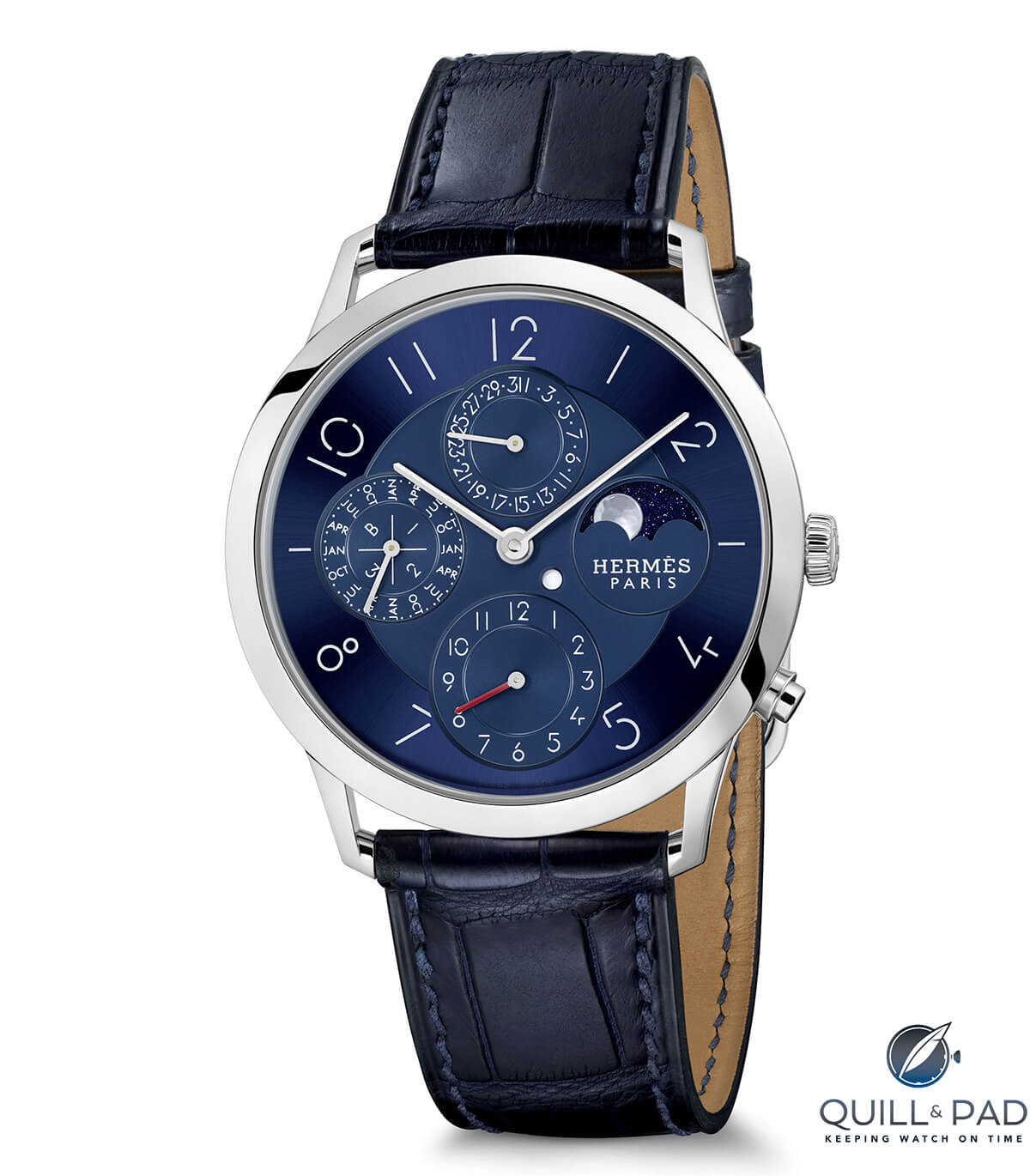
Hermès Slim d’Hermès Quantième Perpetuel platinum with blue galvanized dial
Dials, which are both visible and protected, understandably received a lot of the attention, with enamel and metal plating showing the best longevity.
Paints and other adhered or glued materials tend to discolor, flake off, crack, or disintegrate, creating dust inside the watch case, which is obviously not good for the movements. The most well-preserved century-old wristwatches we find now are almost always precious metal and/or outfitted with enamel dials.

The high-fire enamel dial of this Jaquet Droz Perpetual Calendar Éclipse will look just as good in 100 years as now
The most expensive watches of the last hundred years avoided materials that didn’t have a well-established track record for durability and longevity. Which is why many are still in such good condition today.
The same went for cases. As electroplating became a popular choice for coating cases, many low-quality metal cases were gold plated (along with other metals or chrome) and sold as inexpensive alternatives to solid gold cases.
Stainless steel cases were rare in the early part of the last century, the alloy wasn’t in widespread use until later due to metallurgy issues and lack of capable tooling.
So many cases of affordable watches comprised base metal plated with a thin layer of gold.
This plated gold would quickly wear off with use, creating the need for re-plating or completely re-casing a watch. More prestigious watches were made in solid gold, platinum, silver, or other precious metals.
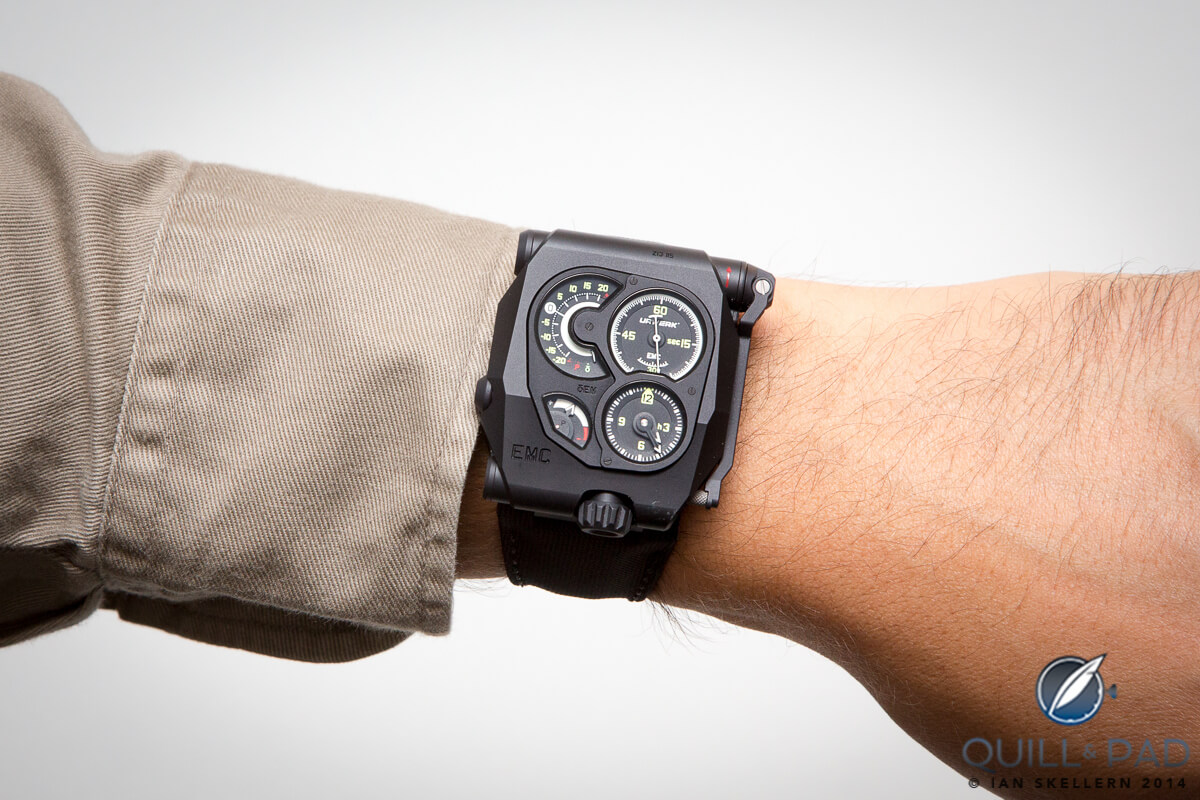
PVD-coated Urwerk EMC Black on the wrist of Felix Baumgartner
But over the last half-century coating technology has advanced rapidly, expanding the options for not only dials and cases, but for nearly any component in a watch. The invention of durable, micron-thin coatings of a variety of materials has created new trends and allowed designers to add colors, protective coatings, and ensure longevity for components.
Nano films (coatings) can be applied in a multitude of ways depending on application, material, and required characteristics.
Coating basics
You may be familiar with at least some of these coatings, having likely seen them in all sorts of places throughout a watch.
The main coating processes are PVD (physical vapor deposition), CVD (chemical vapor deposition), and anodizing, though the latter is usually used on aluminum components that tend to be decorative instead of mechanically functional (though not always).
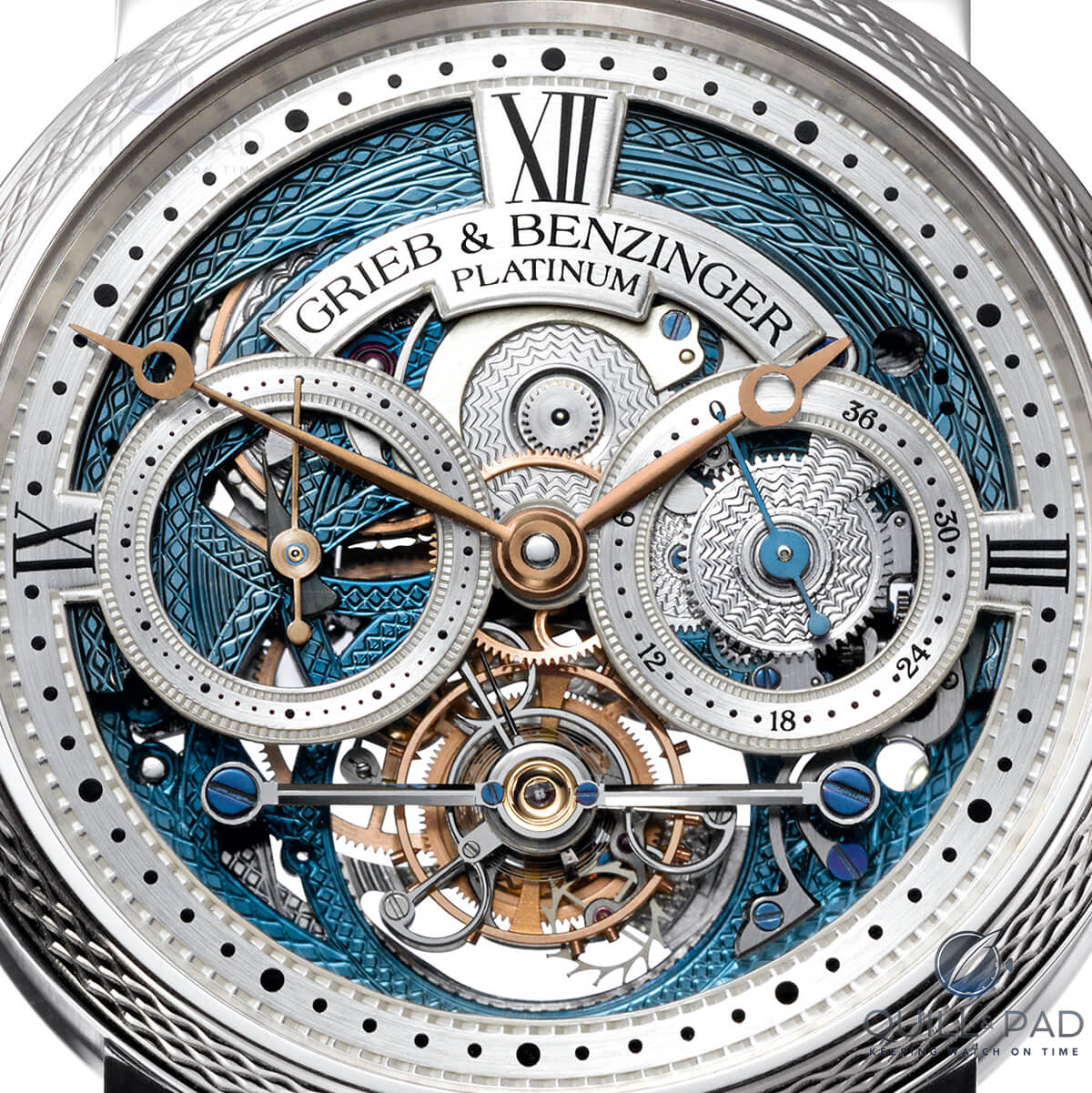
The blue platinum PVD-coated dial of the intricately skeletonized and engraved Grieb & Benzinger Blue Merit
The differences between PVD, CVD, and anodizing usually determine which is used and how. Each of these coatings increase wear-resistance of a surface, with PVD and CVD being more wear-resistant than anodizing.
Anodizing increases an oxide layer on the outside of a material, whereas PVD and CVD coatings add new material, usually very hard metals or ceramics.
DLC (diamond-like carbon) coating is one of the most durable PVD coatings possible; it adds a very thin layer of ultra-hard and smooth diamond-like carbon to the surface.
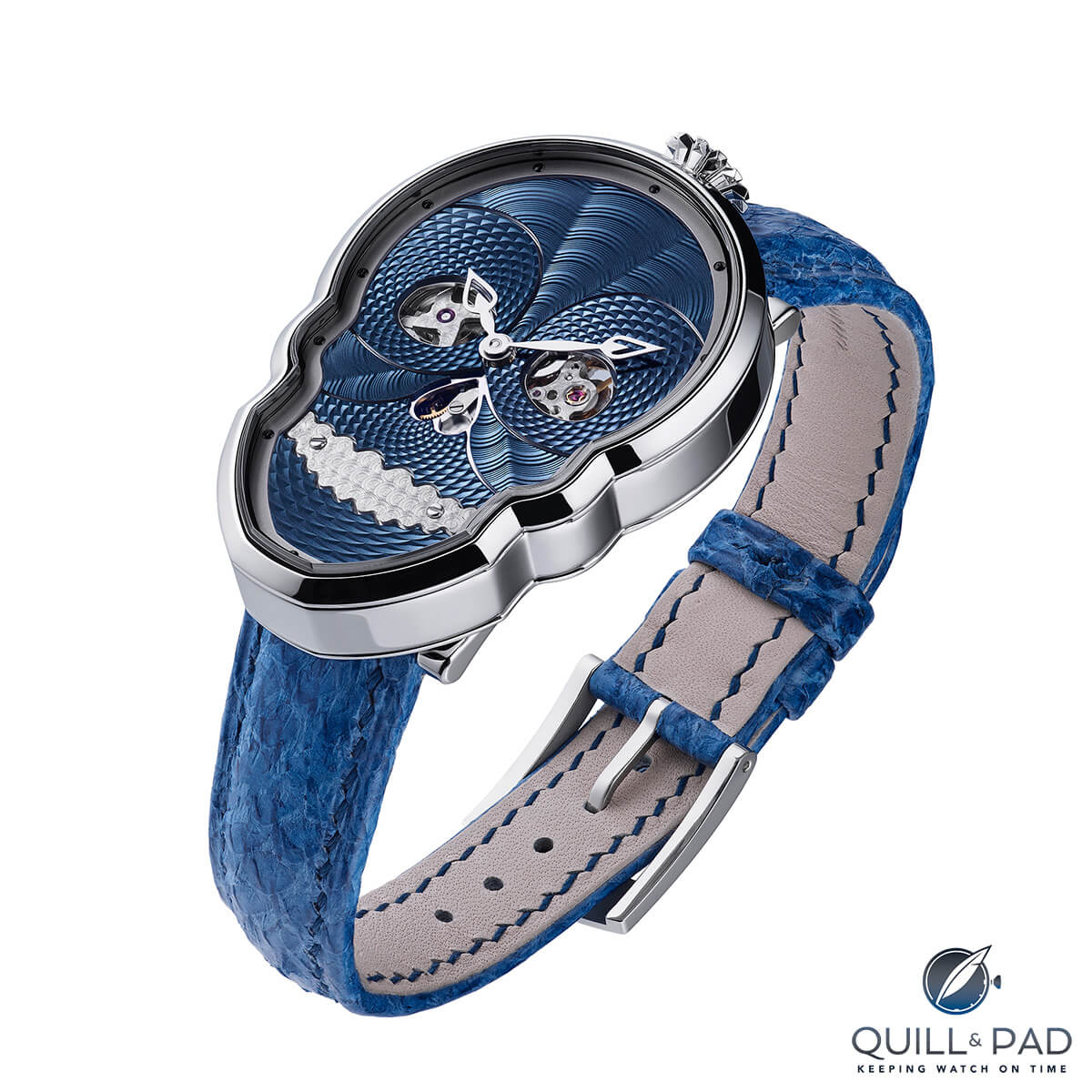
Fiona Krüger Petit Skull Blue boasts a galvanized dial from Kari Voutilainen’s Comblémine dial manufacture
Depending on the material being used for coating, the durability of components can be greatly increased due to lower friction and much harder surfaces. And while these attributes are highly desirable, they are usually utilized just as much for the aesthetic beauty the coatings can create than for improving the base material’s physical properties.
Taking an entire movement and coating it with gold or rhodium is great, but being able to apply a variety of colors, changing the surface finishes of visible faces, and creating never-before-possible contrasts is where the magic lies.
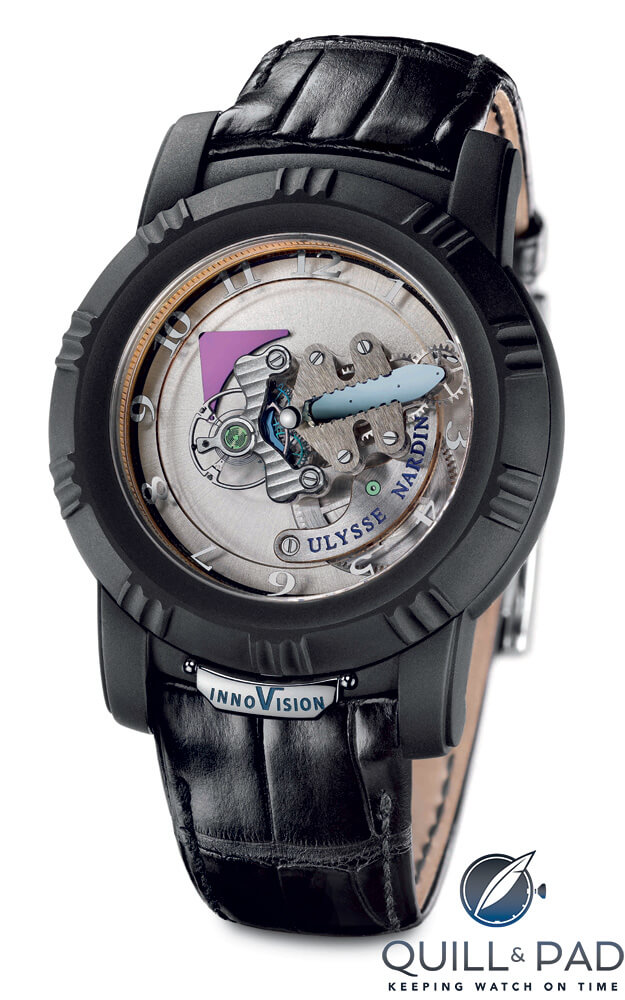
Ulysse Nardin’s original InnoVision was housed in a black PVD-coated case
PVD and CVD coatings are mere microns thick, meaning that they don’t change the surface finish except for hue as they don’t create any surface texture.
Surface texture is usually created in the finishing that happens before coating. If you polish a surface to a perfect mirror and then coat that surface with DLC, the result will be a highly polished black surface.
This aspect of the nano film coatings is used to great lengths to create texture and contrast with individual components and sometimes in multiple places on a single component.
Imagine being able to highly polish a beveled edge on a bridge and then coat that bridge with DLC. Then the top surface could be machined, brushed, blasted, hand-hammered, and engraved to create not only a finish contrast, but a color contrast that would have been nearly impossible before.
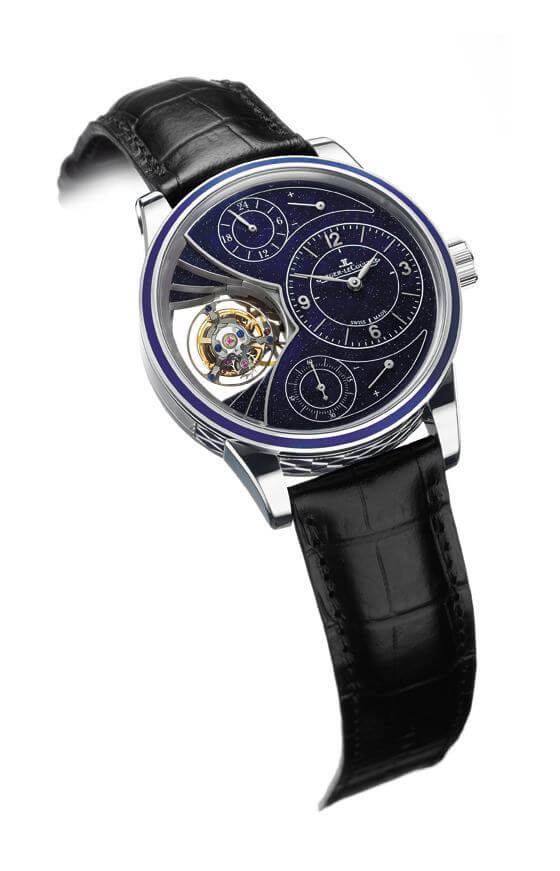
Jaeger-LeCoultre Hybris Artistica Duomètre Sphérotourbillon Enamel
This type of contrast is employed all over a well-designed watch now. Cases can now have not just the standard polished, brushed, and satinized finishes, but can also be coated to create durable colors, and more importantly, design options.
No longer are they restricted to a limited color palette (with a limited usage) and a lack of contrast.
There are new kids on the block, and one of them is Vantablack
Science keeps pushing the coatings technology forward, and the most recent entries might be poised to create the biggest disruption with the use of color, contrast, and texture.
The now-defunct independent brand MCT was the first to debut a limited edition of its Sequential One S110 with the very key addition of Vantablack. For anyone that doesn’t follow science blogs or nerd out over material science, Vantablack is currently the blackest material ever created by humans.
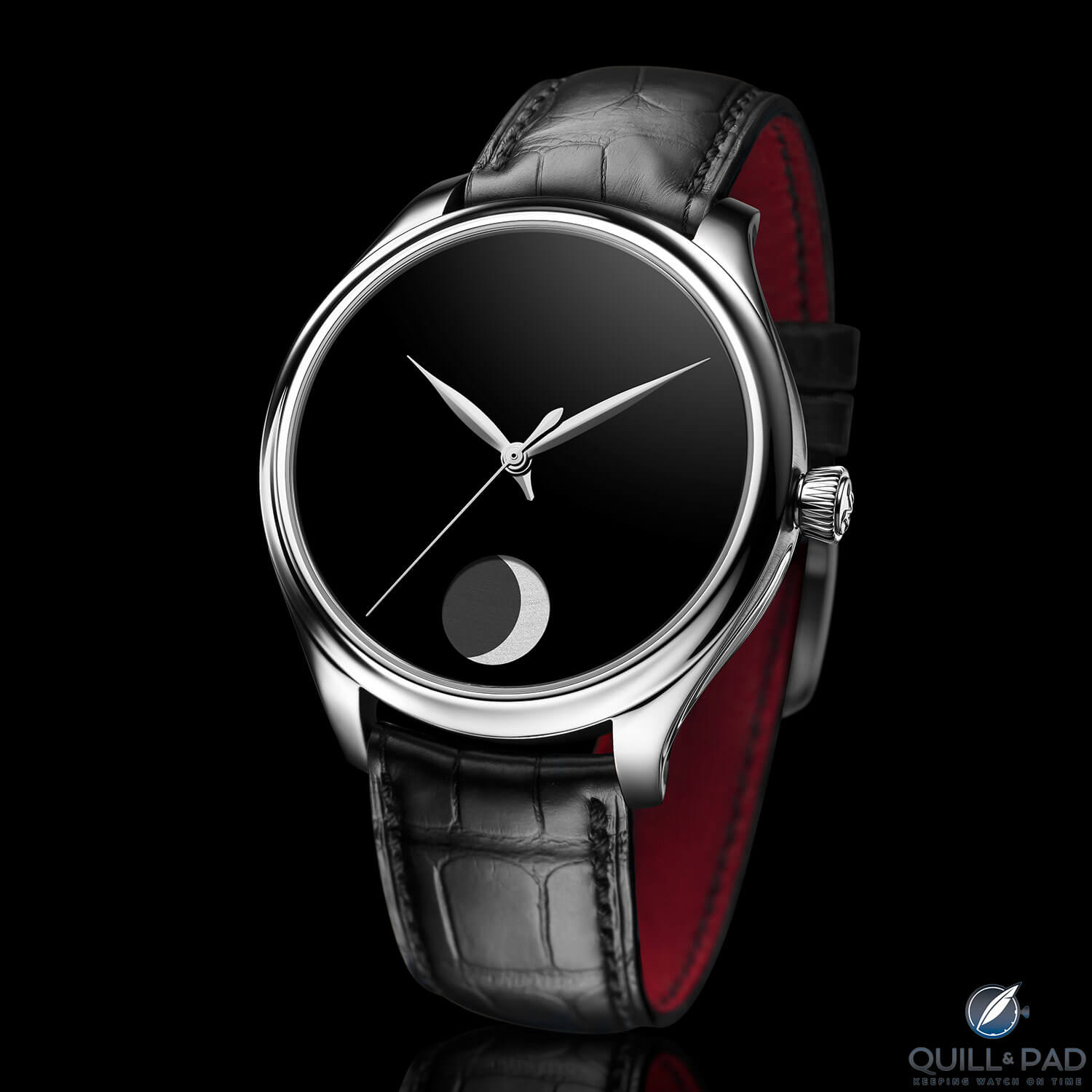
H. Moser & Cie. Endeavour Perpetual Moon Concept Vantablack
This might sound like hyperbole, but “black” is not a color, it is the absence of light. Vantablack has been scientifically proven to have the lowest reflectivity of any material ever made, only reflecting 0.035 percent of visible light. This means it is 99.965 percent effective.
That means that Vantablack does not reflect light that hits it but absorbs it.
Looking into a surface coated with Vantablack is rather troubling as it is extremely difficult to discern where it actually is. When viewed under extreme lighting or from very low angles a very dim reflection can be seen, mainly due to our eye’s extreme sensitivity to light.
The company responsible for creating Vantablack, Surrey NanoSystems, has even improved upon Vantablack, making it so incredibly non-reflective that the spectrometers it uses are having a hard time measuring any light at all reflecting from its surface.
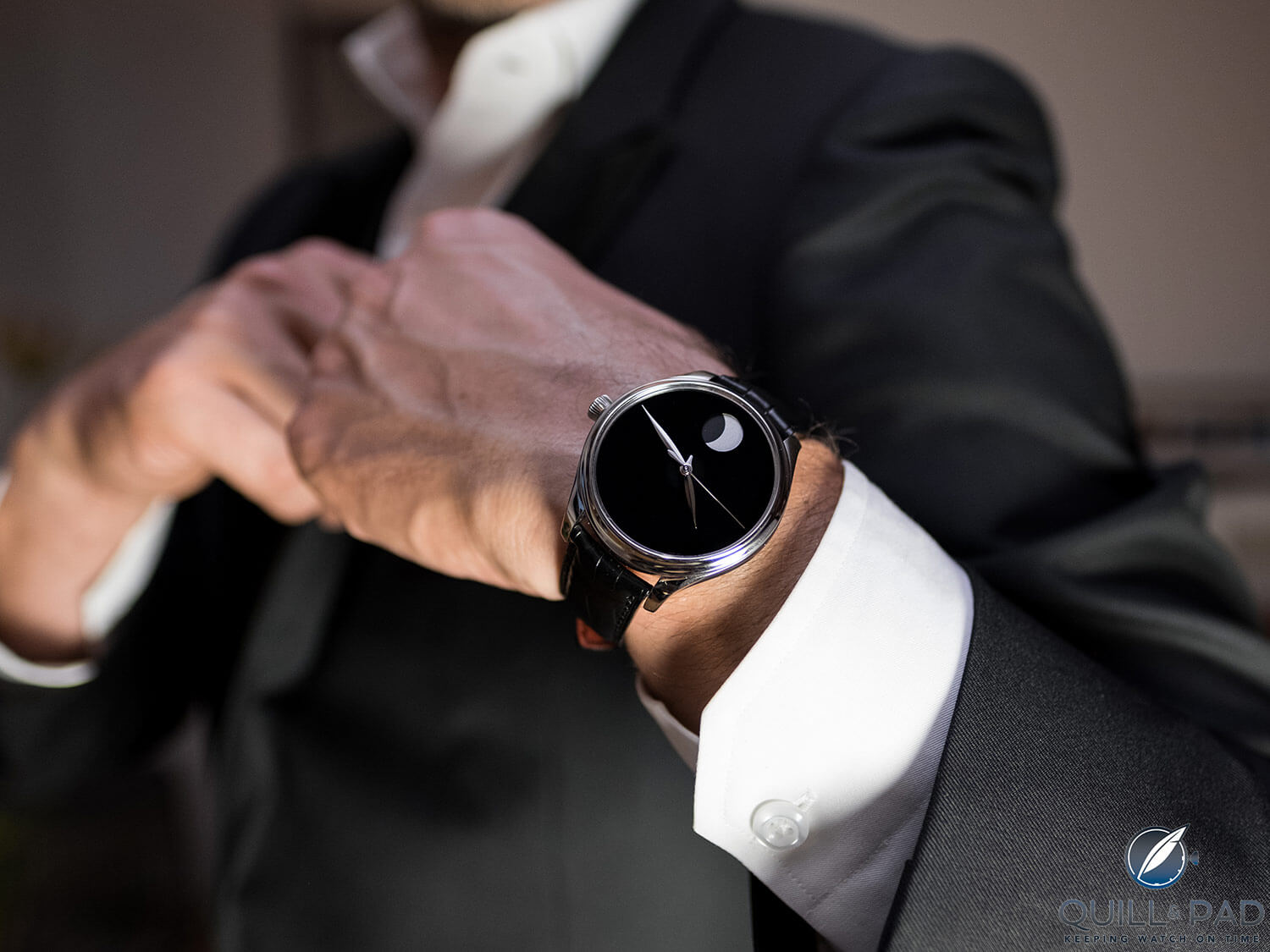
H. Moser & Cie. Endeavour Perpetual Moon Concept Vantablack on CEO Edouard Meylan’s wrist
Vantablack comes from the acronym VANTA, standing for “vertically aligned nano tube arrays,” which are made from carbon nano tubes.
The tubes are deposited/grown through a PVD process requiring extremely precise control of temperature, atmosphere (a pure vacuum is needed), and material deposition. The basics of how it works are that the carbon nano tubes are very tall compared to their diameter, with a length-to-diameter ratio of around 132,000,000:1.
The carbon nano tubes are like a dense forest with three-kilometer-high trees, where light enters but never returns. The only reflective surface is technically the very top end of the nano tube, which, based on structure, only accounts for 0.05 percent of the total surface area.
Basically, this stuff is very black.
The now-defunct MCT used the material to create a floating movement, or at least the illusion of one. The effect is stunning, and more so when you consider that the finishing and textures on the movement are rather traditional, so the ultimate contrast created by brushed and polished parts directly next to a completely non-reflective surface is like nothing seen before.
The implementation of such a black surface into a highly decorated piece is truly a designer’s dream, and Vantablack might have the ability to revolutionize mystery mechanisms inside watches.
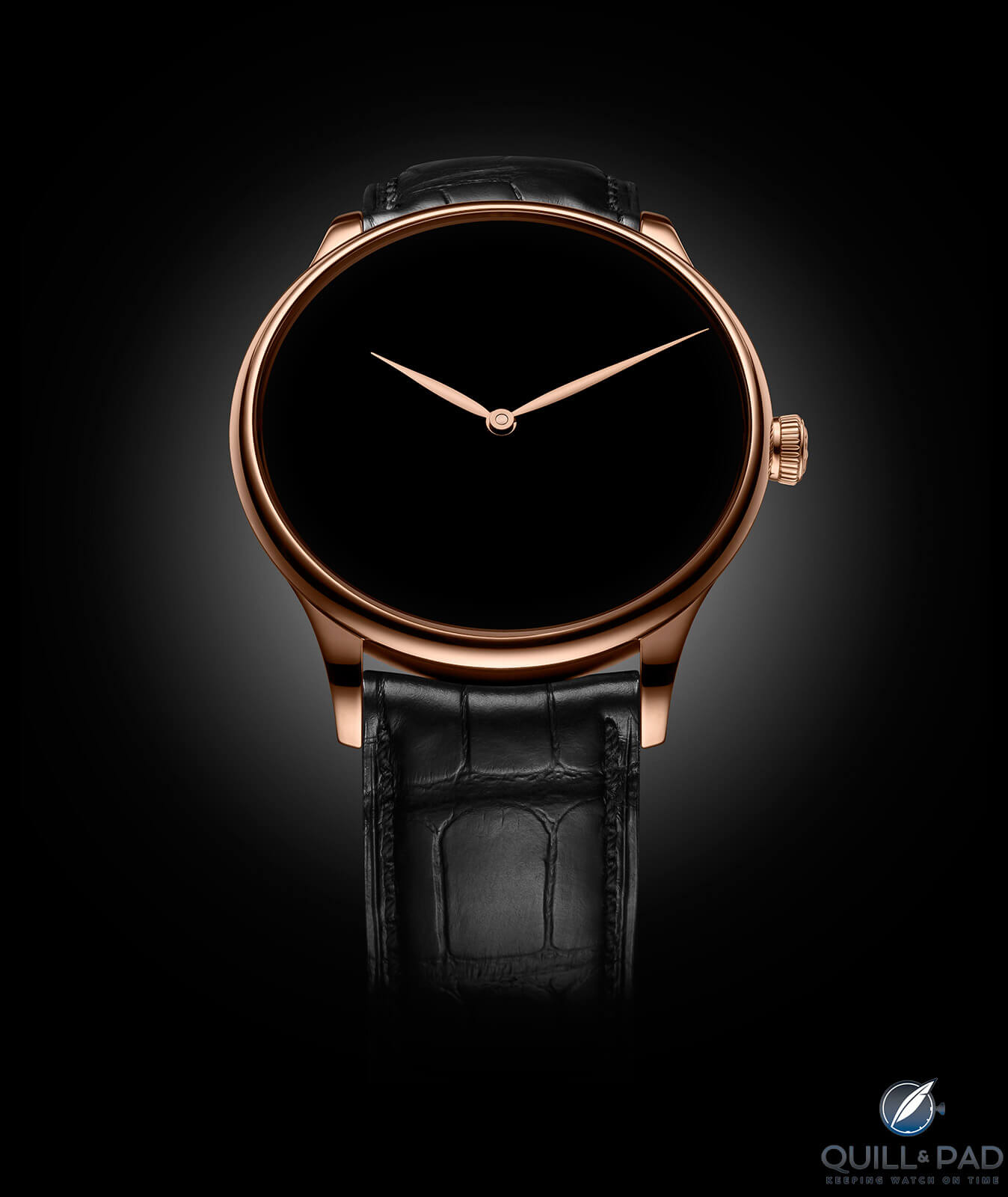
H. Moser & Cie. Venturer Concept Vantablack
Other brands use it to illustrate or showcase other elements of the watch such as hands, which then appear to float like those of the H. Moser & Cie. Venturer Concept Vantablack.
Vantablack is very susceptible to abrasion; it can basically be brushed or scraped off, so for now it will be relegated to interior, decorative components.
Another new material on the horizon has the ability to do for color what Vantablack did for darkness. The material is a chameleon coating made from gold nano rods shaped sort of like a hammer. The gold “nano hammers” are also capable of creating a very black surface around 98.43 percent effective.
But the real magic for this material is in its unique reflective capabilities. If a dye is added, the material no longer absorbs the light but re-emits it in a single frequency, a 100-percent pure color.
This could make for extremely pure color finishes, which, if done properly and placed next to Vantablack, would make for the ultimate in contrast.
This material is still in the research-and-development phase and, of course, has no immediate application in watchmaking as it is being developed for similar scientific applications as was Vantablack. But the future could hold many possibilities as this material and more are developed for other industries before spilling over into the world of horology.
New materials add finishing options, too
Implementing new coatings is not the end, however, of the finishing discussion.
As coating technology has advanced, so has material science, which opens an entirely new dimension to the aspect of finishing.
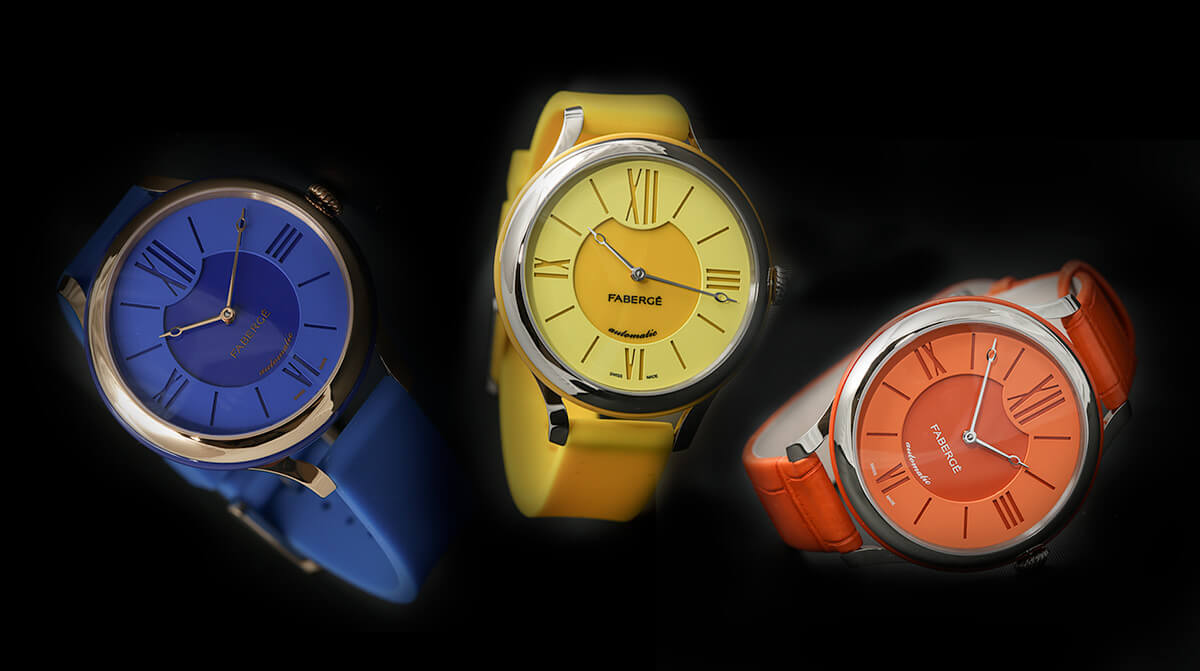
Lady Fabergé 36 mm in the happy galvanized colors of blue, yellow, and orange
New materials present new challenges for finishing, but also new opportunities to create variation and contrast in ways previously unavailable. The introduction and use of materials like stainless steel, titanium, magnesium, cobalt-chrome, carbon fiber, forged carbon, ceramic, sapphire, silicon, and fused quartz has dramatically expanded options for designers.
Many of the new materials are lighter, stronger, more durable, and all around more capable than previous materials, which allows them to be utilized for more demanding tasks. Precious metals are soft, some PVD coatings wear off quickly, and traditionally used metals were heavy.
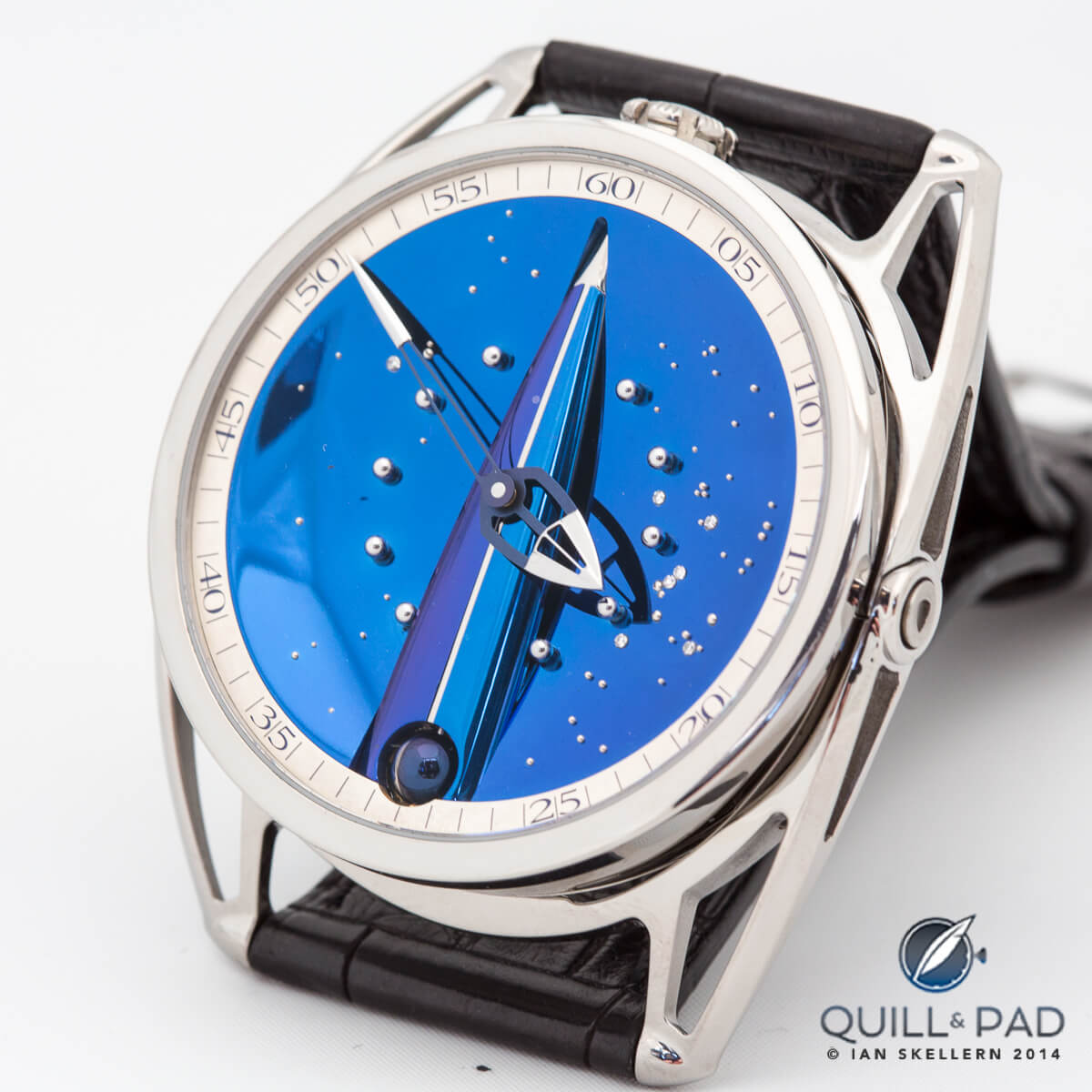
Heat-blued titanium dial on the De Bethune Skybridge
Swap in titanium or ceramic and all of a sudden you have light and strong materials that can be finished in a broad array of styles as well as treated with a multitude of coatings for even more durability.
Durability in watches is one of the limiting design factors, because it doesn’t matter if something looks amazing if it breaks or fades immediately. That is why there has been such a quick adoption of PVD, CVD, and anodized coatings for different components. Adding these coatings to harder and more durable materials means that the finishes last much longer.
Other materials themselves present new finish opportunities like the varieties of carbon, ceramic, and now machined sapphire and FemtoPrint fused quartz.
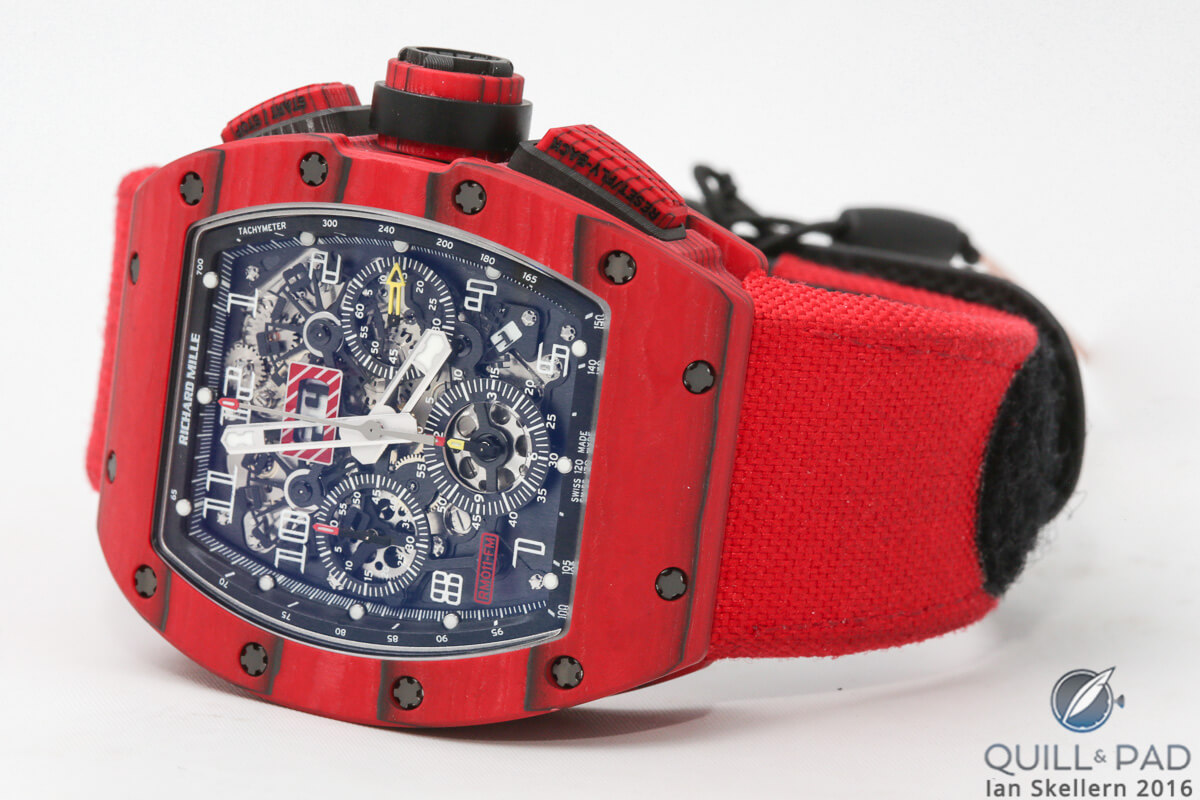
Richard Mille RM 011 Red TPT Quartz Automatic Flyback Chronograph utilizes light new materials in place of heavy traditional materials
The glass-like properties of ceramic, sapphire, and fused quartz are being utilized all over the place to create incredible transparent (yet strong) components. And layered carbon fiber and forged carbon have inserted new surfaces and textures into all sorts of places where only metals had been used previously.
The option to go different routes and still maintain strength, durability, and lightness is one of the holy grails of watchmaking.
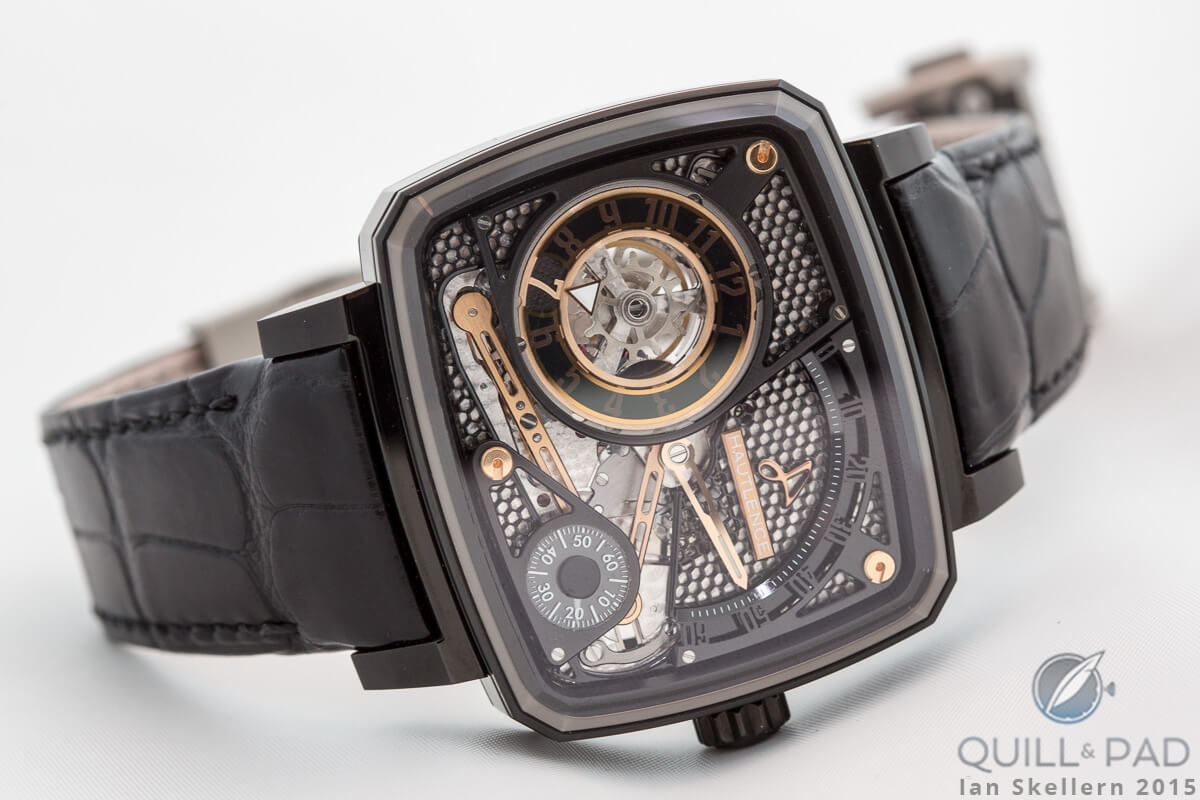
HL Black Ceramic by Hautlence
The old norms of finishing are changing with new materials and coatings, giving watches much better performance and longevity. But to designers, the world of choice has expanded dramatically when it comes to all the elements of design.
Being able to create variety with color, shape, texture, space, and form because of new materials and new coatings like the blackest black in Vantablack has made the future of watch design much more varied and open.
When designers have more materials to choose from, and watchmakers have more options for manufacturing, the intersection can only prove to be better for us, the watch fanatics.
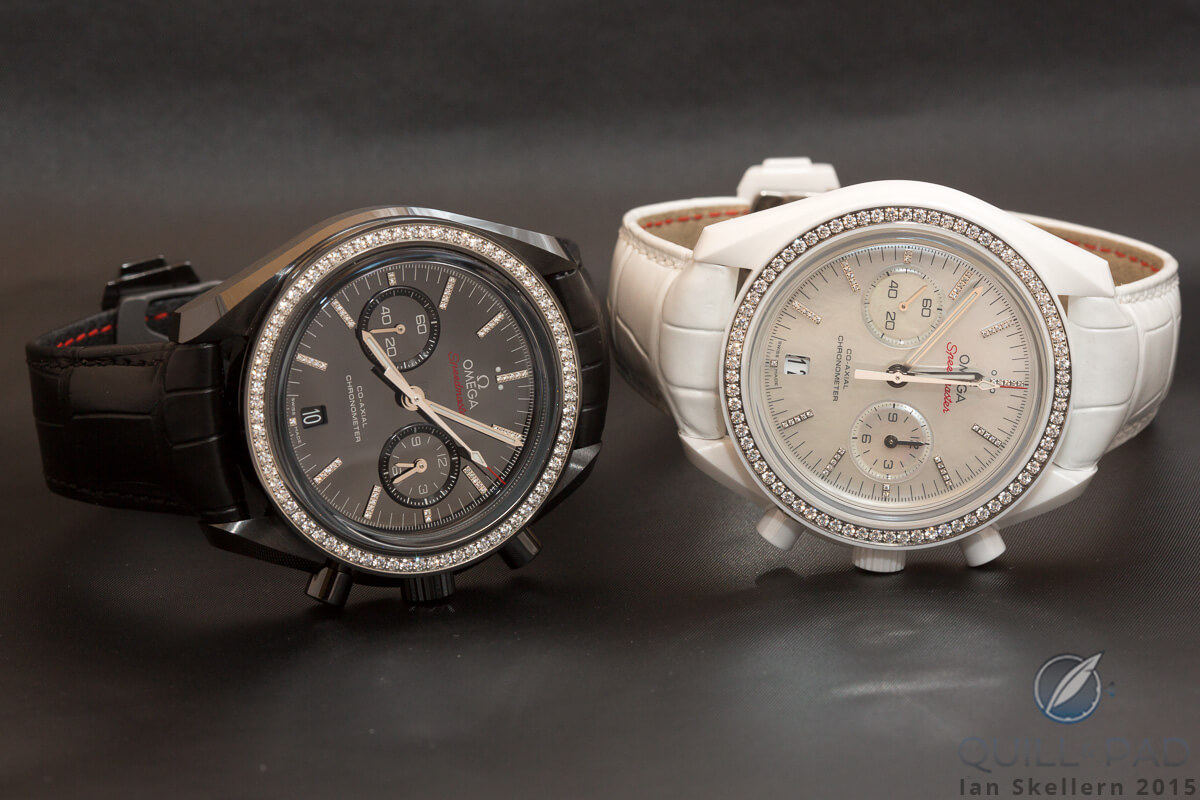
Diamond-set versions of the ceramic Omega Speedmaster Grey Side of the Moon and White Side of the Moon
We’ve already seen the advancements make the Omega Speedmaster much more sought after with the Dark, Grey, and White Side of the Moon ceramic editions, and perennial favorites around the industry are following suit with similar re-imagining.
I’m fairly certain that the new releases will see much more incorporation of coatings, materials, and combinations of the two.
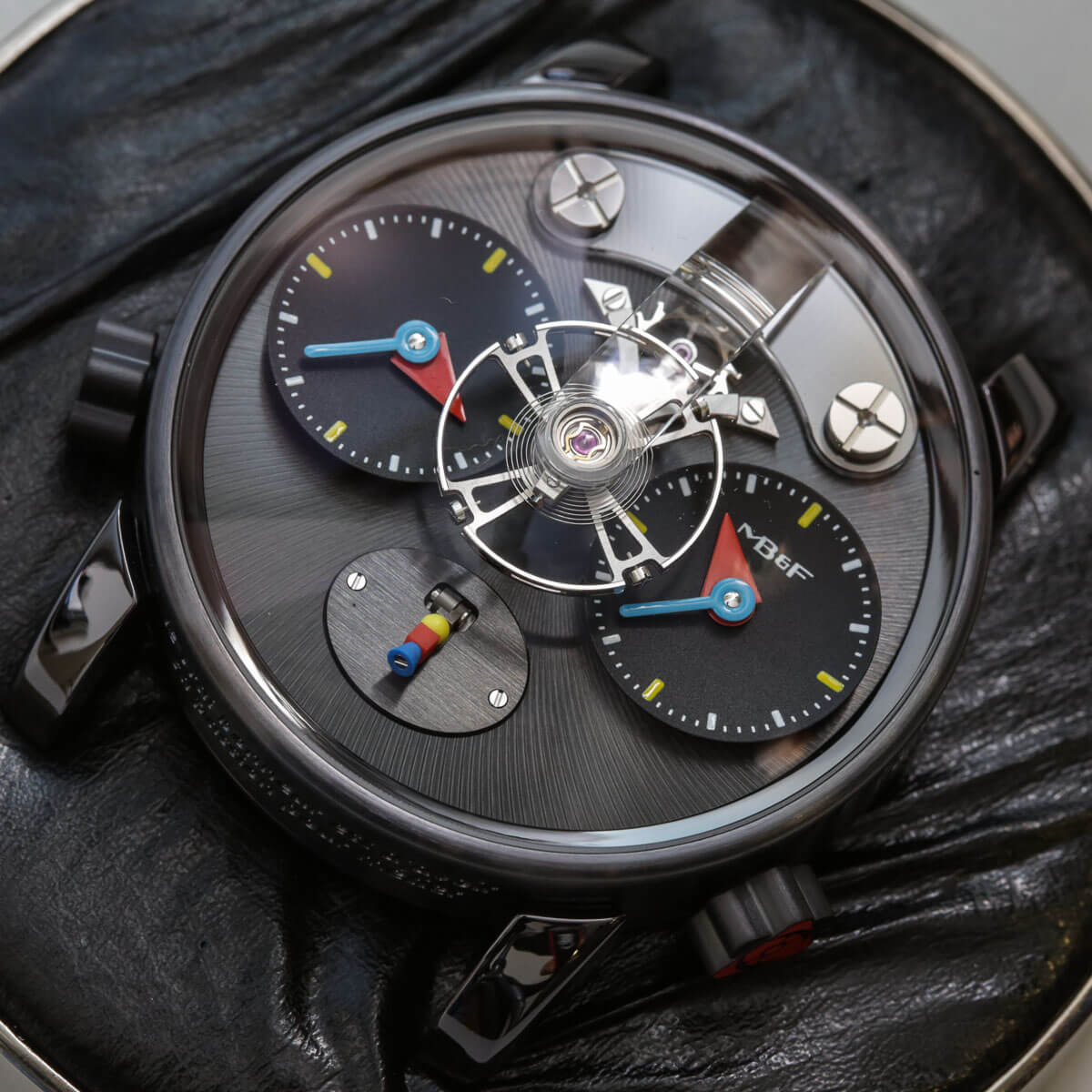
MB&F LM1 Silberstein in blackened titanium
It’s as if science has given watch enthusiasts a new hope.
For more information on Vantablack, please visit www.surreynanosystems.com/vantablack.
Quick Facts H. Moser & Cie. Venturer Concept Vantablack
Case: 39 x 11.9 mm, red gold
Movement: manual wind Caliber HMC 327, 18,000 vph/2.5 Hz frequency, 72-hour power reserve, Straumann hairspring
Functions: hours, minutes; power reserve indicator (on the back)
Limitation: 100 pieces
Price: $27,600/25,000 Swiss francs
Quick Facts H. Moser & Cie. Endeavour Perpetual Moon Concept Vantablack
Case: 42 x 12.9 mm, red gold or stainless steel
Movement: in-house manual winding Caliber HMC 801 with 7-day power reserve; 2.5 Hz/18,000 vph frequency, twin spring barrels, Straumann hairspring
Functions: hours, minutes, (hacking) seconds; day/night indication, moon phase
Limitation: 50 pieces
Price: $35,000
* This article is an update on an article first published on March 18, 2017 at Design Discussion On Contrast & Texture: How Vantablack And Other Techs Are Disrupting Watch Norms.
You may also enjoy:
Moser & Cie. Venturer Concept Vantablack: Perfection Exists
The 10 Most Accurate Moon Phase Wristwatches Today (Plus Honorable Mention)
Back In Black: 3 New Watches With Black Dials From Patek Philippe, Hublot, And Omega
Christiaan Van Der Klaauw Planetarium Black Aventurine: Enigmatic Material Exposed





















































Leave a Reply
Want to join the discussion?Feel free to contribute!